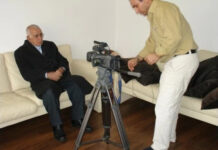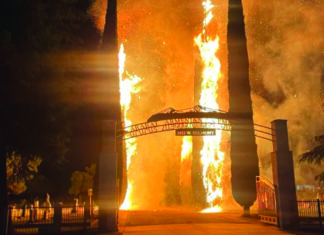By Vicken Cheterian
VENICE, Italy — The Golden Lion for Best National Participation at Venice Biennale 2015, whose slogan is “All the World’s Futures,” has been awarded
to the Republic of Armenia, “for forming a pavilion based on a people in diaspora . . . [in] a year that witnesses a significant milestone for the Armenian people.” The winning pavilion bears the title “Armenity/Haiyutioun: Contemporary artists from the Armenian Dia- spora”; and “milestone” is a polite euphemism for the centenary of the genocide of Armenians by Ottoman Turks. The pavilion houses the work of sixteen artists who live and work outside Armenia — in Aleppo, Istanbul, New York, Buenos Aires and elsewhere — but have one thing in common: they are descendants of genocide survivors, part of a network that is transparent, yet tangible. What could make a diaspora, marked by a century of genocide and its denial, the best representative of our future?
We have a starting date for the Armenian genocide: April 24, 1915, when the Turkish police arrested hundreds of Armenian intellectuals in Istanbul, marking the beginning of a
vast project of mass deportation and murder. What we do not have is an end date. Compare this to the Holocaust, which is remembered on the day the Red Army liberated Auschwitz, putting an end to the atrocity. For Armenians, the end never came, since Turkey continues to deny the crime. Much of the debate has focused on whether what happened is technically a “genocide” or not – but that is silly. What matters is that Turkey is not ready to recognize its responsibility. This fact has consequences: survivors cannot bury their dead, refugees have never been allowed to return to their land, and Turkey still imposes a severe blockade on land-locked Armenia.
Armenians were, of course, a people of diaspora even before the genocide of 1915. Following the nomadic invasions from Central Asia in the eleventh century, which destroyed the Bagratid Kingdom, Armenians lived for many centuries without a proper state. They survived by preserving their distinct identity, thanks, in part, to the Armenian Apostolic Church (the national Church of the Armenians), and to the distinctive features of their culture, which crystallized around the Armenian alphabet and language. Diaspora communities sprang up and blossomed in distant merchant colonies, from Isfahan to Dacca, Cairo to Warsaw. This dispersed nation, globalized before its time, could always count on new recruits from its historic heartland where a significant number of Armenians remained, divided between the “East Armenians” living in the Persian and later Tsarist Empire, and “West Armenians” under Ottoman domination.









